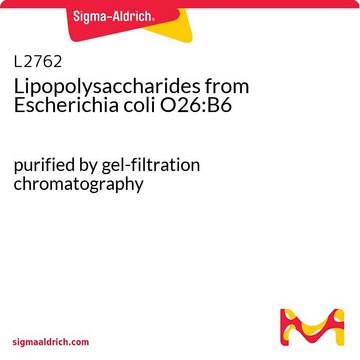L3880
Lipopolysaccharides from Escherichia coli O127:B8
purified by trichloroacetic acid extraction
Sinónimos:
LPS
Iniciar sesiónpara Ver la Fijación de precios por contrato y de la organización
About This Item
Productos recomendados
origen biológico
Escherichia coli (O127:B8)
Nivel de calidad
Formulario
lyophilized powder
purificado por
trichloroacetic acid extraction
impurezas
1-10% Protein (Lowry)
Condiciones de envío
ambient
temp. de almacenamiento
2-8°C
¿Está buscando productos similares? Visita Guía de comparación de productos
Descripción general
This product is TCA extracted from E. coli serotype O127:B8. The source strain is ATCC 12740. This LPS serotype has been used in the study of septic shock and to induce NOS in murine macrophages and PAF synthesis in rat glomerular masangial cells.
Aplicación
Lipopolysaccharides (LPSs) are characteristic components of the cell wall of Gram-negative bacteria. LPS and its lipid A moiety stimulate cells of the innate immune system by the Toll-like receptor 4 (TLR4), a member of the Toll-like receptor protein family, which recognizes common pathogen-associated molecular-patterns (PAMPs).
Acciones bioquímicas o fisiológicas
Lipopolysaccharides (LPS) are localized in the outer layer of the membrane and are, in noncapsulated strains, exposed on the cell surface. They contribute to the integrity of the outer membrane, and protect the cell against the action of bile salts and lipophilic antibiotics.
Nota de preparación
The product is soluble in water (5 mg/ml) or cell culture medium (1 mg/ml) yielding a hazy, faint yellow solution. A more concentrated, though still hazy, solution (20 mg/ml) has been achieved in aqueous saline after vortexing and warming to 70-80 oC. Lipopolysaccharides are molecules that form micelles in every solvent. Hazy solutions are observed in water and phosphate buffered saline. Organic solvents do not give clearer solutions. Methanol yields a turbid suspension with floaters, while water yields a homogeneously hazy solution.
Otras notas
To gain a comprehensive understanding of our extensive range of Lipopolysaccharides for your research, we encourage you to visit our Carbohydrates Category page.
Producto relacionado
Referencia del producto
Descripción
Precios
Palabra de señalización
Danger
Frases de peligro
Consejos de prudencia
Clasificaciones de peligro
Acute Tox. 2 Oral
Código de clase de almacenamiento
6.1A - Combustible acute toxic Cat. 1 and 2 / very toxic hazardous materials
Clase de riesgo para el agua (WGK)
WGK 3
Punto de inflamabilidad (°F)
Not applicable
Punto de inflamabilidad (°C)
Not applicable
Elija entre una de las versiones más recientes:
¿Ya tiene este producto?
Encuentre la documentación para los productos que ha comprado recientemente en la Biblioteca de documentos.
Los clientes también vieron
Shiu-Ming Kuo et al.
The Journal of nutrition, 135(10), 2411-2416 (2005-09-24)
Sublethal exposure to Escherichia coli endotoxin [lipopolysaccharide (LPS)] attenuates the lethal effects of subsequent insults associated with oxidative stress, such as higher LPS dose, septic peritonitis, and ischemia. Because administration of the antioxidant ascorbate protects against these same insults and
Mandakh Bekhbat et al.
Brain, behavior, and immunity, 76, 248-257 (2018-12-15)
Adversity during development is a reliable predictor of psychiatric disorders such as depression and anxiety which are increasingly recognized to have an immune component. We have previously demonstrated that chronic adolescent stress (CAS) in rats leads to depressive-like behavior in
Claudia Patrignani et al.
Journal of inflammation (London, England), 7, 16-16 (2010-04-01)
PTPH1 is a protein tyrosine phosphatase expressed in T cells but its effect on immune response is still controversial. PTPH1 dephosphorylates TCRzeta in vitro, inhibiting the downstream inflammatory signaling pathway, however no immunological phenotype has been detected in primary T
F Dhainaut et al.
Vox sanguinis, 104(2), 115-126 (2012-09-26)
To compare in vitro and in vivo biological and biochemical properties of five liquid intravenous immunoglobulin (IVIg) preparations licensed for therapeutic use in Europe. ClairYg(®) was compared in a blinded manner to four other liquid IVIg preparations licensed in Europe
Hong Li et al.
International journal of biological sciences, 16(7), 1107-1120 (2020-03-17)
Traumatic brain injury (TBI) induces an acute inflammatory response in the central nervous system that involves both resident and peripheral immune cells. The ensuing chronic neuroinflammation causes cell death and tissue damage and may contribute to neurodegeneration. The molecular mechanisms
Nuestro equipo de científicos tiene experiencia en todas las áreas de investigación: Ciencias de la vida, Ciencia de los materiales, Síntesis química, Cromatografía, Analítica y muchas otras.
Póngase en contacto con el Servicio técnico


